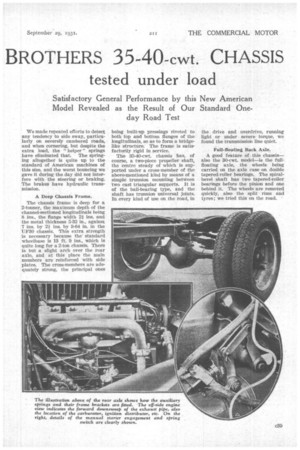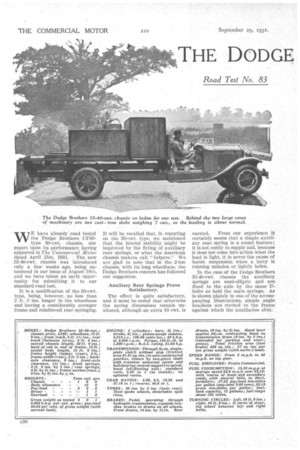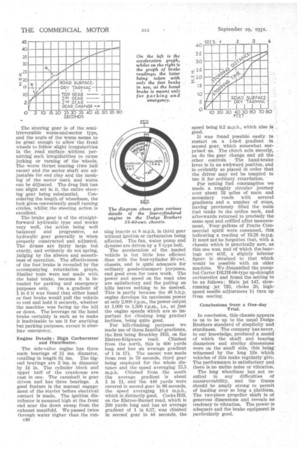BROTHERS 35-40-cwt. CHASSIS
Page 61

Page 60

Page 62

If you've noticed an error in this article please click here to report it so we can fix it.
tested under load
Satisfactory General Performance by this New American Model Revealed as the Result of Our Standard Oneday Road Test WE have already road tested the Dodge Brothers T_JF30type 30-cwt. . chassis, our report upon its performance having appeared in The Commercial Motor dated April 21st, 1931. .. The new .3540-cwt..: chassis was introduced only a few weeks ago, being' announced in our issue of August '18th, and we have taken an early opportunity far. submitting it to our
standard road test. "
It is a modification of the 307cwt. type, being, however, no less than 2 ft. 5 ins, longer in the wheelbase and having a considerably stronger frame and reinforced rear springing.
It will be recalled that, in reporting on the .30-cwt. type, we mentioned that the lateral stability might be improved by the fitting of auxiliary , rear springs, or what the American chassis makers call helpers." We are glad to note that in the 2-ton chassis, with its long wheelbase, the Dodge Brothers concern has followed our suggestion.
Auxiliary Rear Springs Prove Satisfactory. , The effect is. quite satisfactory, and it must be noted that otherwise the spring dimensions remain unaltered, although an extra 10 cwt. is carried. From our experience it certainly seems that a simple auxiliary rear spring is a sound feature; it is not costly to supply and, because it does not come into action when the load is light, it is never the cause of harsh suspension when a lorry is running unladen or lightly laden.
In the case of the Dodge Brothers 35-40-cwt. chassis the auxiliary springs are semi-elliptic and are fixed to the axle by the same IT-. bolts as hold the main, springs. As is shown plainly in one: of the accompanying illustrations, simple angle brackets are riveted -to..the frame: against which the auxiliaries abut;..
We made repeated efforts to detect any tendency to side sway, particularly on severely cambered roads, and when cornering, but despite the extra load, the " helper" . springs have eliminated that • The springing altogether is quite up to the standard of American machines of this size, and the worst bouncing we gave it during the day .did not interfere with the steering or braking. The brakes have hydraulic transmission.
A Deep Chassis Frame.
The chassis frame is deep for a 2-tonner, the maximum depth of the channel-sectioned longitudinals being 8 ins., the flange width 2i ill.S, and the metal thickness 5-32 in., against 7 ins. by 2i ins. by 9-64 in. in the tle30 chassis. This extra strength is necessary because the standard wheelbase is 13 ft. 9 ins., which is quite long for a 2-ton chassis. There Is but a slight arch over the rear axle, and at this place the main members are reinforced with side
• plates. The cross-members are adequately strong, the principal ones being built-up pressings riveted to both top and bottom flanges of the longitudinals, so as to form a bridgelike structure: The frame is satisfactorily rigid in service.
The 35-40-cwt. chassis has, of course, a two-piece propeller shaft, the centre steady of which is supported under a cross-member of the above-mentioned kind by means of a simple trunnion mounting between two cast triangular supports. It is of the ball-bearing type, and the shaft has trtuinion universal joints. In every kind of use on the road, in the drive and overdrive, running light or under severe torque, we found the transmission line quiet.
Full-floating Back Axle.
A good fea.ture of this chassis— also the •30-cwt. model—is the fullfloating axle, the wheels being carried on the axle case on double tapered-roller bearings. The spiralbevel shaft has two tapered-roller bearings before the pinion and one behind it. The wheels are removed quickly, also the split rims and tyres; we tried this on the road.
The steering gear is of the semiirreversible worm-and-sector type, and the angle of the worm seems to be great enough to allow the front wheels to follow slight irregularities in the road surface , without perinitting such irregularities to cause jerking or turning of the wheels. The worm thrust bearing (two .ball races) and the sector shaft are adjustable for end play and the meshing of the sector teeth and worm can be Idjusted. The drag link has one slight set in it, the entire steer
ing gear being substantial. Considering the length of wheelbase, the Jock gives conveniently small turning circles, whilst the steering action is excellent.
The brake gear is of the straightforward hydraulic type and works very well, the action being well balanced and progressive, as hydraulic gear generally is when properly constructed and adjusted. The drums are fairly large but sturdy, and evidently do not spring, judging by the silence and smoothness of operation. The effectiveness of the foot brake is revealed by the accompanying retardation graph. Similar tests were not made with the hand brake, because it is intended for parking and emergency purposes only. On a gradient of 1 in 6 it was found that either hand or foot brake would pull the vehicle to rest and hold it securely, whether the machine was facing up the hill or down. The leverage on the hand brake certainly is such as to make it inadvisable to use it for anything but parking purposes, except in absolute emergency.
Engine Details : High Carburetter and Distributor.
The side-valve engine has three main bearings of 2i ins, diameter, totalling in length 6* ins. The bigend bearings are 2 ins, in diameter by 11 in. The cylinder block and upper half of the crankcase are cast in one. The camshaft is gear driven and has three bearings A good feature is the manual engagement of the starter before electrical contact is made. The ignition distributor is mounted high at the front end near the down sweep from the exhaust manifold. We passed twice through water higher than the run e40 ning boards at 8 m.p.h. in third gear without ignition or carburation being affected. The fan, water pump and dynamo are driven by a V-type belt.
The acceleration of the loaded vehicle is but little less efficient than with the four-cylinder 30-cwt. chassis, and is quite adequate for ordinary goods-transport purposes, and good even for town work. The power and speed on the road also are satisfactory and the pulling on hills leaves nothing to be desired. This is partly because the 48 b.h.p. engine develops its maximum power at only 2,800 r.p.m., the power output at 1,000 to 1,500 r.p.m., i.e., at just the engine speeds which are so important for climbing long gradual inclines, being quite good.
For hill-climbing purposes we made use of three familiar gradients, the first being Brockley Hill, on the Elstree-Edgware road. Climbed from the north, this is 600 yards long and has an average gradient of 1 in 17*. The ascent was made from rest in 78 seconds, third gear being employed for the whole distance and the speed averaging 15.5. m.p.h. Climbed from the south the average gradient is about 1 in 11, and the 440 yards were covered in second gear in 86 seconds, the speed averaging 10.4 m.p.h., which is distinctly, good. Cocks Hill, on the Elstree-Barnet road, which is 200 yards long and has an average gradient of 1 in 8.57, was climbed in second gear in 44 seconds, the
speed being 9.2 m.p.h., which also is good.
It was found possible easily to restart on a 1-in-6 gradient in second gear, which somewhat surprised us. The clutch acts sweetly, as do the gear change and all the other controls. The hand-brake lever, is in an awkward position, and is evidently so placed in order that the driver may not be tempted to use it for ordinary retardation.
For testing fuel consumption we made a roughly circular journey over about 53 miles of main and secondary roads with several gradients and a number of stops, having previously filled the main fuel tanks to the orifice neck, and afterwards returned to precisely the same spot and refilled after measurement. Four gallons of Pratts Commercial spirit were consumed, this indicating a reading of 13.28 m.p.g. It must not be forgotten that, with a chassis which is practically new, as this one was, and of which the bearings are stiff, a slightly inferior figure is obtained to that which would be possible with an older machine. We dismantled the pumpfed Carter DR.TH-08-type up-draught carburetter and found the setting to be as follows Main jet 147, slowrunning -jet 735. choke 20, highspeed needle-adjustment 1i turn up from seating. . .
Conclusions from a One-day Trial.
In conclusion, this chassis appears to us to be up to the usual Dodge Brothers standard of simplicity and sturdiness. The company has never, to our knowledge, produced a model of which the shaft and bearing diameters and similar dimensions were on the small side, this being witnessed by the long life which vehicles of this make regularly give. The performance is satisfactory and there is no undue noise or vibration.
The long wheelbase has not resulted in any difficulties of manceuvrability, and the frame should be amply strong to permit of loading over so long a platform. The two-piece propeller shaft is of generous dimensions and reveals no tendency to vibration. The power is adequate and the brake equipment is particularly good.












































































































